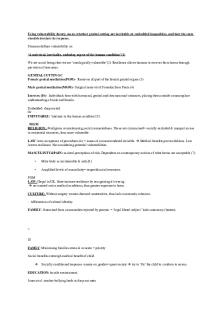Quantification Using Turbidimetry PDF

| Title | Quantification Using Turbidimetry |
|---|---|
| Course | General Microbiology |
| Institution | California State University Fullerton |
| Pages | 3 |
| File Size | 196.3 KB |
| File Type | |
| Total Downloads | 29 |
| Total Views | 138 |
Summary
Quantification Using Turbidimetry...
Description
Part 2: QUANTIFICATION USING TURBIDIMETRY Materials: • TSB (Tryptic Soy Broth) • Cultures: • Escherichia coli (108 org/ml)
Methods: (Write down what you did, step by step) Refer to pages 54 in the BIOL302 spring 2021 Lab manual. The lab was conducted through by the instructor and result were given Results: (Any graphs? Screen shot/cropped data? Etc)
Figure legend: (Briefly and concisely explain what data I am looking at) The picture above show the E.coli tube at different concentration which their concentration is determined is calculated and their OD reading is determined using spectrophotometry. Discussion: (Interpret what you see, why is it important, and why it look that way. Any improvements? Future direction? Using the serial dilution, the original sample was diluted into different concentrations and using spectrophotometry the concentration and the data from this experiment can be used to graph concentration vs OD reading and this experiment result can be used in future experiments. Since this experiment was the mixture of very important methods in biology I would have preferred if I was able to conduct this experiment in the laboratory and did not only have the final result.
concentration vs. O.D. 1.4
O.D. 595 nm
1.2 1 0.8 0.6 0.4 0.2 0
0
20000000
40000000
60000000
80000000
100000000 120000000
concentration Logarithmic ()
TDF2 TDF4 TDF8 TDF16 TSB Blank
Questions: OD Concetration Reading 100000000 1.215 50000000 0.85 25000000 0.523 12500000 0.284 6250000 0.158 0 0
(Answer all questions found from your lab manual section) 1. What are the advantages and disadvantages of the various quantitation methods? Direct counts: easy method to count all cells in the sample, however it cannot distinguish between dead and live cells Plate count: very useful if we have high concentration sample, however it involves too many steps Filtration: Very useful method when our starting material concentration is low, its complicated and prone to error Turbidimetry: fast method to count cells better result compare to other methods
2. Why must you use a separate pipette to make each dilution, but use only a single pipette to plate the diluted materials? There is high chance of contamination while we are doing serial dilution also by changing tips we can make sure no extra amount of cells move from one tube to another On the other hand while we are using pipette to plate a diluted materials the chance of contamination is low and the amount that we are moving to plate doesn’t make any difference 3. Explain why a standard curve is valid only for a single microbe in one type of medium.
All microbe have different rate of cell division and therefore have different curve meaning they have different log phase different Exponential growth different stationary and death phase so it does make sense that the standard curve is only valid for single microbe 4. Why must an uninoculated control be used for turbidimetric readings? It is used as a background read, and it will also tell us if the machine that we are using actually work. Usually we went the back ground read to be zero so it doesn’t interfere with our experiment...
Similar Free PDFs

Quantification Data Analysis
- 6 Pages

Chamber-Quantification-Summary
- 18 Pages

Using Studiosity
- 2 Pages

Using winfact
- 20 Pages

Using MyDesktop
- 2 Pages

Using a critiquing framework
- 3 Pages

BLUETOOTH CAR USING ARDUINO
- 49 Pages

Questionnaire analysis using spss
- 14 Pages

5.1 Using Anatomical Terminology
- 4 Pages

Using vulnerability theory
- 4 Pages
Popular Institutions
- Tinajero National High School - Annex
- Politeknik Caltex Riau
- Yokohama City University
- SGT University
- University of Al-Qadisiyah
- Divine Word College of Vigan
- Techniek College Rotterdam
- Universidade de Santiago
- Universiti Teknologi MARA Cawangan Johor Kampus Pasir Gudang
- Poltekkes Kemenkes Yogyakarta
- Baguio City National High School
- Colegio san marcos
- preparatoria uno
- Centro de Bachillerato Tecnológico Industrial y de Servicios No. 107
- Dalian Maritime University
- Quang Trung Secondary School
- Colegio Tecnológico en Informática
- Corporación Regional de Educación Superior
- Grupo CEDVA
- Dar Al Uloom University
- Centro de Estudios Preuniversitarios de la Universidad Nacional de Ingeniería
- 上智大学
- Aakash International School, Nuna Majara
- San Felipe Neri Catholic School
- Kang Chiao International School - New Taipei City
- Misamis Occidental National High School
- Institución Educativa Escuela Normal Juan Ladrilleros
- Kolehiyo ng Pantukan
- Batanes State College
- Instituto Continental
- Sekolah Menengah Kejuruan Kesehatan Kaltara (Tarakan)
- Colegio de La Inmaculada Concepcion - Cebu





